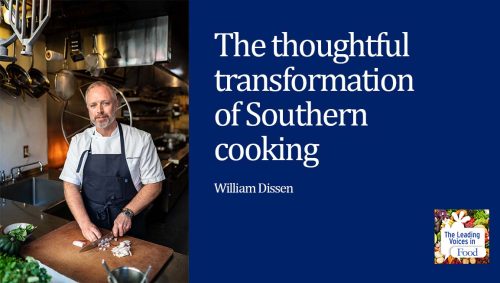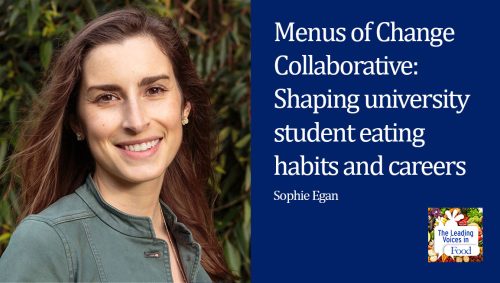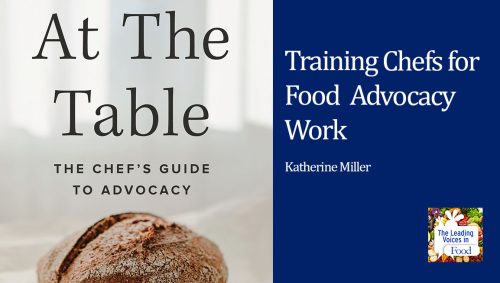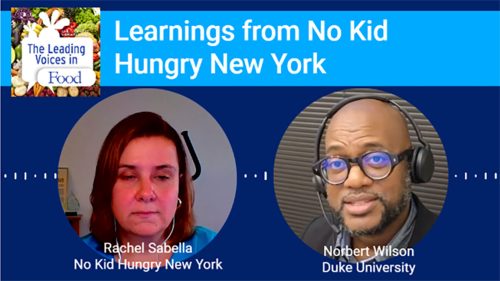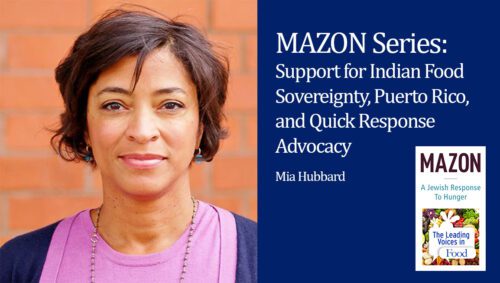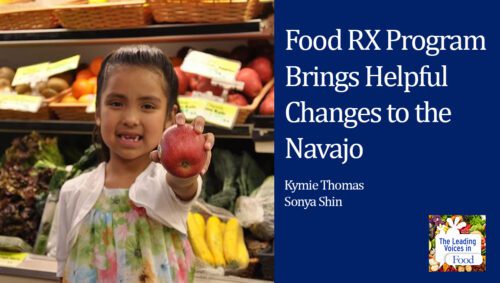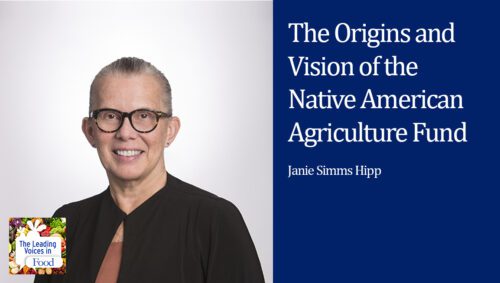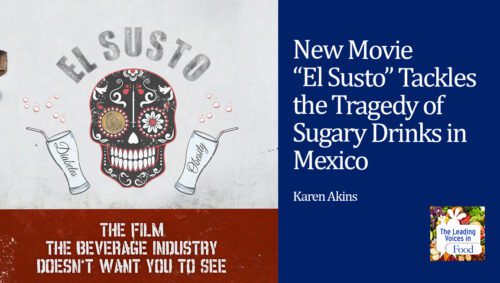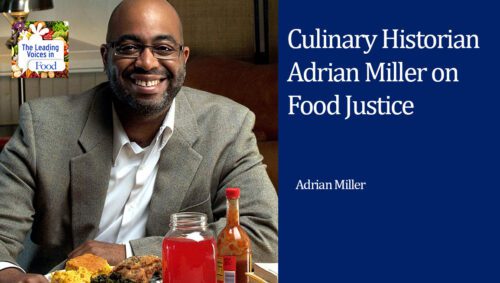The Leading Voices in Food
E103: Film Discussion – Sanjay Rawal on GATHER
Today, we’re celebrating the power of stories in creating shared understanding. We’re talking with James Beard award-winning filmmaker Sanjay Rawal. The creative force behind a new movie about Native American food ways called “Gather.” Gather is an intimate portrait of the growing movement amongst Native Americans to reclaim their spiritual, political and cultural identities through food sovereignty, while battling the trauma of centuries of genocide.
Subscribe: Apple Podcasts | TuneIN | YouTube Music | SoundCloud | PocketCasts | Radio Public
Tags: Chefs & Food Writers | Equity, Race & Food Justice | First Nations Food Issues | History & Food | Movies & Food |

Sanjay Rawal is a James Beard Award winning filmmaker and the creator of Gather (http://gather.film). He previously made FOOD CHAINS (EP Eva Longoria, Eric Schlosser) which chronicled the battle of the Coalition of Immokalee Workers, a small group of Oaxacan and Chiapan indigenous farmworkers in Florida, against the largest agribusiness conglomerates in the world. The film was released theatrically in a number of countries (Screen Media in the US) and won numerous awards – including citations from the US Conference of Mayors, the Clinton Global Initiative and the White House. The film was also a Winner (shared) of the 2016 BritDoc Impact award and several festival prizes. Sanjay’s last film 3100: RUN AND BECOME won several festival prizes, had a robust theatrical release in the US in 2018 and is opening in traditional theatrical engagements across Europe and Australia in 2020 and 2021.
Interview Summary
So let’s begin, would you please describe the Gather film for our listeners and talk about why you took on this very ambitious project.
Gather is a new film released a few months back in September, and it’s on the kind of esoteric subject of food sovereignty. What does that even mean? Well, we follow three sets of characters who are all citizens of different tribal nations on turtle Island, what’s now the United States. We follow a chef Neefa Craig, who is a French trained Culinary professional who has returned to his home land, his reservation the White Mountain Apache tribal land in Eastern Arizona, to set up a high-end affordable restaurant that will deepen people’s understanding of Apache food traditions. We also follow a young Lakota woman who grew up on a Buffalo ranch in South Dakota on the Cheyenne River Sioux nation, Elsie DuBray, and she’s a scientist. She’s studying the benefits of their traditional food – bison. And we follow a group of young gentlemen on the Klamath river in Northern California as they contend with the presence of a gigantic dam that’s decimated the river health and salmon populations that have sustained their people for millennia. So through these interwoven stories I believe we present a very compelling narrative of a movement happening in tribal nations right now to reassert their sovereignty by reestablishing food ways that were taken away from them by the colonial extractive government of the United States.
The early Anglo European economy was based on mono crop agriculture. How did that change what were once profoundly bio-diverse lands? What are they like now?
That’s a great set of issues to discuss. We live in an era right now where we are so separated from the food and the land that it’s hard to imagine that less than 150 years ago almost the entirety of the American economy was land-based. And when you look at the groups in Europe that were beginning this kind of new wave of colonization and the 1400 and 1500s, you basically had two sets of goals. You had nation States that were hiring call them entrepreneurs, call them state-sanctioned pirates. They were hiring people to go and be the number one find mountains of gold. And there was an another set of nation States that realized that the wealth that they could extract was from the top soil itself. And those were the Anglo European nation States who in the beginning funded Italian explorers to come and make an assessment of the Eastern seaboard of what’s now the United States. Those explorers saw that far from being wild terrain, they encountered highly advanced agricultural populations that had a deep understanding of farming animal, stewardship, foraging, waterways, fishing, et cetera. And they began to realize they could use the fertility that natives had built into their farming practices, use the fertility and that land and create economies of scale. They could force natives off their land, essentially keep that land with zero operating costs forever. And eventually they went to West Africa to find bodies, to find agrarian experts as it were, and enslaved those people and brought them to turtle Island. And so in a matter of a hundred years there was a massive farm economy primarily set up to send goods back to Europe. Cash crops like cotton, like tobacco. And the early American economy prized its relationship with continental Europe to a great degree because it relied on the purchase of these export cash crops to generate and maintain wealth in the new economy. The American story is really one of land theft and one of practicing very destructive monocropping practices that would generate as much wealth as quickly as possible for the investors.
So it’s tragic what’s happened to the native American food ways. And of course, to the people themselves. Based on your learning and creating this film, what observations can you make about how the US supply chain serves people today in Indian country particularly since the COVID pandemic occurred?
I’ll go back to colonial history for a second. By the 1760s, the American farming economy had nearly exhausted the health of top soil on the Eastern seaboard. And American farmers wanted to push West of the Appalachian mountain range, and the British forbade that. Now, why would the British even care? Well, to support that sort of – we call that euphemistically exploration – a number of native people would need to be forcibly displaced again from their land. And that would require military support and the British were unwilling to provide that military support. But one of the first things the Continental Congress did was establish the Northwest ordinance which opened up Indiana, Ohio, and those States East of the Mississippi to farmers. Not in the sense of the family farmers that we referred to now, but as folks that were in a sense land pirates. They were going and stealing land with force and then creating economies of scale to sell those goods back to the Eastern seaboard and eventually export that.
So on the Eastern seaboard, with the exception of Florida, there was all an almost immediate displacement of native populations. And with the Louisiana Purchase there was this intention of establishing lands West of the Mississippi for native populations forever. Keeping in mind that there’s no such thing as Native American – there’s hundreds of federally recognized tribes, and hundreds more people that don’t have that kind of political distinction. A number of populations like the Cherokee, And the Seminole, and the Creek were forced marched from the Southeast and placed in Oklahoma in lands that were completely foreign to their practices their science, their way of life, and their creation stories.
But as more immigrants began entering the US and wanting to stake out their own economic claim and not work for other people in cities, the only way to do so was to have a piece of land. A big piece of land to grow enough corn or wheat and to be able to sell it for a profit. That was the push West of the Mississippi. All along this way, native populations were forced into smaller and smaller and smaller parcels of land. And they were being forced to assimilate into the US and to become farmers themselves. Even if they were nomadic. Even if they followed herds of Buffalo throughout the year. Even if they foraged or even if they fished.
At the same time, because the US economy relied so much on the best quality land, Natives were effectively pushed to the worst quality farmable land. And as supply chain systems began being developed and refined in the United States railroads were built from the West back to the East. And the highway system was built on top of those at the same time. Keeping in mind that natives are pushed away from urban centers as much as possible, They remained completely untouched or unserved by the supply chain. So right now in Indian country they are at the end or the terminus of supply chains. Which is why you don’t find a lot of grocery stores there. Because grocery stores are expensive to run and they require a lot of people shopping and spending a lot of money. For the most part, people in indigenous communities have to drive 50, 60, to 100 miles to get access to the same sorts of foods that midsize or small sized American cities have access to.
Now, if you wouldn’t mind returning to the issue of how people perceive the land. What you brought up earlier was very interesting. You’re painting a picture of one group of people who have descended from Anglo Europeans who see the land as something that can be owned and something that is there to be exploited where the Native Americans have a different approach to it. It’s sort of a spiritual harmony that they have with the land, and the ownership is perceived much differently. Would you mind expanding on that a bit?
Keeping in mind that the early American economy was based on land and enslaved people, we can see the institutional ramifications of slavery in the way that, for example, law enforcement generally tends to treat African-Americans right now. When it comes to native issues it’s important to note that land in North America, on turtle Island, always had a direct value for the economy. And you see the ramifications now in institutions like the USDA, where one of its many functions is measuring the economic output of land, and giving loans and guarantees so that people farming land can hit certain benchmarks. But the system isn’t set up to have farmable land fallow it’s not set up to allow the land to regenerate.
The native view of land was multi-century long. It was restorative, it was regenerative. It was the opposite, we should say of extractive. It was understanding that the land can only give human beings so much and that humans need to understand the balance. So that generations seven, eight, nine, 10 in the future can have the same unspoiled relationship with the land that generations now have. Now, when it comes to American policy either things are extracted or things aren’t extracted, as in farming land versus national forest. There’s no sense of the fact that we do need to take, we can take, but everything needs to be in balance. And that’s what is missing from an equation, and I don’t mean this in a bad way, but in an economic sense there’s always a factor of greed. Whether it’s unadulterated greed or just wanting a little bit more. And that very ethos has never really been symbiotic with the Native American environmental ethos.
So one part of the gather project focused on journalism and I know that your team hired a number of Native American journalists and photographers to report on some of these issues you’re talking about regarding food sovereignty. Can you talk about why collecting those stories was so important and what you did with them?
The practice of documentary filmmaking is inherently – you know, this is a heavy word – it’s inherently exploitative where you’re going into a community and you’re taking stories. And there’s a whole series of expectations that people have that might not ever meet together in the middle. When someone comes to you and they share their story it’s with the expectation that they could be in your film. But anybody who knows a little bit about filmmaking knows that you have to talk to a lot of people to be able to find the stories that are going to be best suited to the visual medium that film is. You’ll come across so many stories that might be better told by photographs, they might be better told in words. And that’s what happened to us. In our development of this project we visited a number of tribal communities, came across dozens of stories that had such deep importance and people were offering with their heart and soul.
So as we began to see which stories wouldn’t be suitable for the restrictive format of documentary filmmaking, we began look for grants to hire Native American journalists and photographers to write up and tell those stories. And we hired Kim Baca, who used to be the Executive Director of the Native American Journalist Association. And she worked with me on placing those stories in tribal media and in non-tribal media. Hopefully we were able to do the people that we met a service and allow the inspiration that wanted to share with us as filmmakers, be shared in some other format.
So much came of this effort not just the film, which is amazing itself, thanks for sharing that. So when you interacted with so many people in the making of this filming, what are your impressions?
I have made several films that had native characters. My first film was called “Food Chains” and there was about a group of tomato pickers in Florida called the coalition of Immokalee workers. And they’re primarily seen as Latino but there are in fact displaced indigenous Oaxaca and Chiapas and Guatemalan migrants. For whom Spanish might be a second or third language. My second film “3,100 Run and Become” was about ultra distance running but we had a sun bushmen Hunter character from the Kalahari and we had a Navajo ultra marathoner from the Navajo reservation. I had already developed, you know, a pretty deep affinity for native American and indigenous culture because it reminded me so much of what I knew to be the village life that my father and my mother grew up in an India. And so going into Indian country, I believe I could relate to people simply because I was a good listener. And I knew I was in a world that would gradually unfold itself to me if I was just quiet, if I just built the trust wasn’t loud and gave respect to the fact that the folks I was meeting with had histories on their land of one, two, five, 10, 20,000 plus years. And it’s always such an amazing experience to be with people that understand where they are and where they’ve come from in ways that the rest of us on turtle Island in the United States can’t do as immigrants. Whether we’re first-generation or 20th generation we don’t have the same sort of perspective that the folks in gather do. While some of the characters were younger than me, some of them were older than me. I kind of felt the deep wisdom that they had and really enjoyed learning about their stories by just listening for hours on end.
So what do you hope will come out of people watching your film?
In Indian country, there’s been a whole series of reactions and those are the ones that we made the film for, people taking pride in reestablishing the food systems that were in effect destroyed by colonization. And when I say destroyed, I mean directly by the mid-1800s, it became really clear to the US government that the expenditure of military force on native people was too perilous. And it was euphemistically much more efficient to subjugate native people by destroying their food systems. Whether it meant creating policies and procedures to take the massive Buffalo herds from the Midwest from 63 million down to just a handful of individuals, whether it meant burning fields, damming rivers polluting rivers, et cetera. Native Americans are one of the only populations in the modern world to have had their entire food system destroyed as a tactic of war.
Secondly, there was a program for more than a hundred years to forcibly remove native kids from their homes. And in the effort of assimilating them, put them into boarding schools where speaking their language, practicing their culture was forbidden. And so we’ve come to a stage in Indian country where people are trying to preserve the bits of wisdom, connection, and science that still remains. That wasn’t completely destroyed by these two programs. So when they see characters like Twila Cassadore in our film, who is a master forger, one of the most in-tune people with Mother Earth that I’ve ever met – they’re inspired because they realize that their ancestors were exactly like Twila.
Outside Indian country, however, there’ve been a number of really interesting conversations, both on the foundation level because less than 1% of American philanthropy goes to native led organizations working in Indian country. Even though one might argue that all of philanthropy has come from land-based wealth even tech fortunes came from venture capitalists who come from that sort of old pre-industrial revolution or industrial revolution land-based economy.
But in the farming community, there been really, really deep conversations. Because at some point in the history of the land that we’re on whether your family was directly involved or whether we just purchase it from somebody who purchased it from somebody else, the land that we’re on was once somebody’s home. And chances are the histories of those homes still exist within Native American families and groups that have been displaced. And it’s kind of horrific when you think that. If you try to imagine somewhere in your ancestry your grandparents lost their homes, your great grandparents were forcibly removed and maybe passed away. The only modern corollary is the Holocaust. And I don’t say that lightly because in the Meinkaupf Hitler does allude to Native American reservations as precursor ideas for his ideas of concentration camps. And so the fact that our history, even though the ideals of America are so lofty, was based on a set of deeply horrific practices: the enslavement of Africans, and the theft of Native American land – has caused people to really contemplate what sort of future they want to live in. And the idea of equity and redistribution of wealth and resources that were taken in a very inequitable fashion.
If you’re interested in learning more about Gather, you can find information online at gather.film and you can watch it on iTunes, Amazon, and Vimeo on demand.

